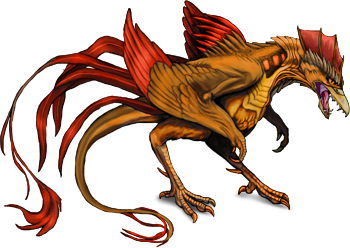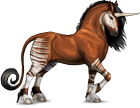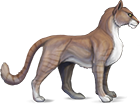Posted at 2013-10-08 05:27:22 — Link
To be updated as needed.
NOTE:
Please refer to Beastkeeper's FAQ (click link)
for important questions for any unanswered information.
General Skin Information:
Note: Notice the columns and rows
divided into "A"s and "B"s with a number following after the letter.
The skin library library is easily broken down into this:
Chestnut Gryphon (A5) + Cat Gryphon(B5) = Tiger
Yellow Puma(A4) + Graying Modifier Puma(B5) = Pastel Siamese
Green/Blue Roc(A5) + Diluted Roc(B4) = Skyblue Roc
So let's say I wanted to make a Okapi Unicorn,
1) I'd open up the Skin Library and look under the Unicorn Color Chart, unless I'm there already.
2) I'd look for the Okapi Unicorn picture
Okapi falls under row A2 (Bay) and column B4 (Zebra)
Bay Unicorn + Zebra Unicorn = Okapi Unicorn
Lets say I needed to know what colors any pet could possibly have out of 4 possible colors.
One helpful way is by looking at the Pedigree of the mother and father.
The second is by looking at the pet color!
This Lilac Puma has 2 colors that can be easily identified by looking at the color chart is falls under.
A5 (Brown) and B4(Diluted)
The third way is by researching genes!
How about mixing the colors between 2 parents together?
Green genes are the dominant, and Gray are the recessive colors.
A pet can only have 2 dominants and 2 recessives = 4 color choices
2 of which are colors for example: Red, Blue
2 of which are patterns for example: Spotted, Striped
Picture example:

|
Orange
|
Blue
|
|
| Diluted |
Normal
|
So, The breakdown
1 pet + 1 pet = 2 pets
4 color choices + 4 color choices = 8 color choices
= 2 Pets with a total of 8 color choices!
That can be a total of 8 colors for children!
How do colors work?
Dilema:
PET 1
Red, Blue
Spotted, Striped
+
PET 2
Green, Silver
Diluted, Piebald
= CHILDREN:
Red Spotted, Red Diluted, Green Spotted, Green Diluted.
Problem: You will not get Blue, Striped, Silver, or Piebald.
HOW TO: Bring out the pets Recessive Colors.
THE FIX:
Example Pet 1:
Red, Blue
Spotted, Striped
BREED WITH:
Either one with a different ___insert color here___ and Blue Recessive, or one that has both Blue Dominant and Blue Recessive.
Solution: (May take a try or 2)
Red, Blue + Yellow, Blue= Child: Blue, Blue
OR:
Red, Blue + Blue, Blue= Child: Blue, Blue
Conclusion: The same should work with patterns like spots, stripes, and the like.
OTHER:
Say your pet has Red, Blue and you really want the color Brown for example, and there is no pet within your resources that have Brown. Check the breeding offers first.
If there is only a pet with colors that look like this:
Yellow, Brown
Solution:
Red, Blue + Yellow, Brown =
1. Red, Blue
2. Yellow, Blue
3. Red, Brown
4. Yellow, Brown
Now, we can breed that brown recessive!
Important Note:
Offspring / children will only look like the ones found in the Skin Library, Custom Skins have no effect on offspring / children, only your chosen pet.
“Obstacles are only obstacles if you see them as obstacles. They can also be called opportunities.”
-Tucker Max






